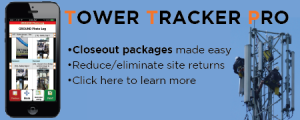Podcast: Play in new window | Download | Embed
Subscribe: Apple Podcasts | RSS
Hell yeah! Don’t get me wrong, you could use CAT 5 to connect most of this stuff, but the idea is to have the equipment everywhere and talking all the time, or at least when we need to. They need to be wireless controlled for it to work properly and to be autonomous. What fun would a drone be if you needed to have a copper line connected to it. The FCC laid out their plan to sunset copper lines. I did a lot of work on them but I won’t miss them because wireless is so cool! If you like copper so much, then put that smartphone down and use a landline, if you can find one.
And now for something different, Kathy over at Tower Safety and Instruction is having a contest where you, yes you, can win a $100 gift card from Home Depot if you can win the contest to provide the best caption for her picture, found at http://towersafety.com/get-ready-enter-tower-safety-super-team-contest/ so get click today and make an entry!
So, back to IOT, (Internet of Things), they rely on wireless connections for more than convenience. This is how the machine to machine, M2M, really take off. Whether it’s to control valves for a water company or to read your electric meter or to control natural gas flow, you need to have connectivity everywhere. We just need to define what that connectivity will be. It could be the standard carrier networks, LTE really. That is going to be key for so much of this. But most of these systems will need much less bandwidth.
Small data networks, that sounds crazy, right? NOT! You see the new networks are built for larger packets, so they are so inefficient, and too expensive, for a simple command to open or close a valve. LTE and Wi-Fi seem like overkill for these applications, although they are everywhere and the most convenient to work with, especially Wi-Fi, it’s in your house and would be a great way for your smart home full of IOT devices to talk to your smartphone and the real world.
Newsletter sign-up!
Subscribe–> iTunes or Stitcher or Overcast
That is why the LTE format may not be the best for IOT, although it would be everywhere so by default it may be the technology of choice.
So how will wireless IOT work?
They need something for outdoor communication like LoRa, the low-bandwidth system. There is a LoRa alliance, https://www.lora-alliance.org/ if you want to read more about what they are up to. Another good article on LoRa is at http://postscapes.com/long-range-wireless-iot-protocol-lora/ where they go into detail about how it works. What they explain is that they are planning to use the spectrum that is left behind, with smaller bandwidth. They way the Semtech chip works is that they utilize spectrum that is sub giga-hertz, like 109MHz, 433MHz, 866MHz, and 915MHz where they have smaller amounts of spectrum. They need to stay away from the license free spectrum because it might interfere.
There is another format called SigFox for outdoor communication. Again, made for very small packets of data. I found information at http://www.link-labs.com/what-is-sigfox/ if you want more information but here is what I got out of it. They are using the 915MHz spectrum (ISM band license free), using 2 types of Phase Shift Keying, PSK. This supposedly will help get the data through the noise. I am not sure what the coverage would be for something like this but I would bet its very limited. This is a low power, wide area, (LPWA) network. A good article on SigFox is here, http://www.networkworld.com/article/3029253/internet-of-things/how-sigfox-plans-to-spread-its-low-power-iot-network-across-the-u-s.html if you want to learn how they plan to deploy. I am told that they already have several deployments in the USA, although I don’t know of any personally.
 Are you a hardcore wireless group? Get the full wireless bundle!
Are you a hardcore wireless group? Get the full wireless bundle!
Now, for the smart home, inside a building, or the smart office, you could use Wi-Fi, ZigBee, Z-Wave, Bluetooth, or something proprietary. We all know Wi-Fi and Bluetooth, right? It’s on your smartphones and in your homes. What we don’t know if ZigBee and Z-Wave.
 The Wireless Deployment Handbook eBook that covers professional carrier end to end deployment of LTE small cells, CRAN, and DAS showing you the proper way to plan for deployment then execute.
The Wireless Deployment Handbook eBook that covers professional carrier end to end deployment of LTE small cells, CRAN, and DAS showing you the proper way to plan for deployment then execute.
What is ZigBee for IOT? Well, according to the ZigBee alliance at http://www.zigbee.org/what-is-zigbee/ it is a wireless language that is used to connect devices, which is such a generic explanation that I could use for any wireless protocol. Come on!
So I went into Wikipedia at https://en.wikipedia.org/wiki/ZigBee where they give a much better explanation. It is line of site, LOS, and very short-range. It works in the ISM band, just like Wi-Fi, (2.4GHz in most countries but also in 915MHz in USA and Australia, 784MHz in China, 868MHz in Europe). The data rate is very small, remember I said smaller packets are all you need? This is made for very small and efficient bursts of data. They also support mesh networking. Mesh means that the devices not only connect to the hub but they can repeat the signal to each other forming a mesh. This is a great way to extend coverage if you don’t need massive bandwidth.
What is Z-Wave for IOT? Z-Wave takes ZigBee and makes some enhancements. It specifically works in the 908.42GHz range in the USA and 868.42MHz band in Europe. For a great explanation go to http://www.smarthome.com/sc-what-is-zwave-home-automation but its made for very small networks in the home. Find more at http://www.z-wave.com/ but I haven’t heard much more on this except that they have a version that will work with the Apple iWatch.
As you can see there are many technologies to roll out the IOT format. I don’t really know if there is a clear winner but I think it depends on the need. The wireless backhaul will come down to a chip they add to the device based on need, coverage, and cost. I could see someone using all of the technologies in a device to get the coverage they need, like maybe utility meters. That would make sense because it would be a one-time up front cost. However, for the in home stuff, cheap is what they need. I seriously don’t see people putting in a new network in their homes if they don’t have to but many companies will say you need a “hub” which will be the special format switch that their devices will, in theory, talk to the Wi-Fi in their homes. I already see it but it looks like they want to sell more devices in the home. So maybe high-end stuff will need the hub. I could see the hub as another line of defense in security, where if someone hacks your Wi-Fi and/or cable router then they would need to get by another device to get to your thermostat or light switches.
TOWER CLIMBING: AN INTRODUCTION (The book about getting started as a tower climber)
However, for an outdoor network I could see a dedicated network taking off for several reasons, cost reliability, and security. It costs money to pay the carrier a fee every month when you have a small low data device on it when you could put one of the cheaper hotspots in a space to connect your devices. Again, it really comes down to cost and reliability. Many will say they want security, but how secure can they really be?
A few more articles that may interest you:
http://postscapes.com/internet-of-things-protocols/
https://en.wikipedia.org/wiki/LPWAN
http://www.semtech.com/wireless-rf/internet-of-things/
https://www.micrium.com/iot/devices/
http://www.networkcomputing.com/internet-things/10-leaders-internet-things-infrastructure/1612927605
https://www.thethingsnetwork.org/
So let me know what you think, email wade4wireless@gmail.com when you think of something to say!
Be smart, be safe, and pay attention!
Do you know what to put in your SOW, the details needed to get paid for milestones or job completion? Would it hold up in claims court? Would you rather plan up front instead of fighting for it after the job is done?
Scope of Work tutorial for the contractor to keep both sides doing the right thing for payment.







